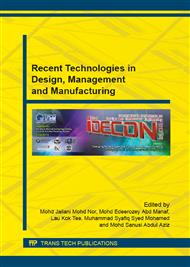p.651
p.659
p.664
p.668
p.673
p.678
p.683
p.688
p.693
The Effects of Roller Conveyor on Muscle Activity in Workpiece Loading on CNC Machining Centre: A Preliminary Study
Abstract:
In the recent years, Advance Manufacturing Technology (AMT) has been widely used in manufacturing industry to increase manufacturing process capability. However, Computer Numerical Control (CNC) machine designs have only focused on its operational capability. The harmonious coordination between users and CNC machines is often neglected, which can contribute to hazardous working practices that can affect the health of users. Bending posture while loading the work piece to the machine can cause fatigue and discomfort to the users. Thus, the focus of this preliminary study is to analyse the effect of CNC machine work piece loading on muscle activity levels and to determine the effectiveness of roller conveyor in reducing muscle activity levels. Muscle activity has been analysed using surface electromyography (sEMG) technique. Erector spinae, biceps and trapezius muscles were concurrently measured during the work piece loading. Five male subjects (n=5) participated in the pre-intervention study and two subjects (n=2) in the post-intervention study (roller conveyor implementation) participated to test the effectiveness of the roller conveyor. Result pre-intervention study found that muscle activity level of biceps was the highest followed by trapezius and erector spinae. Based on the post-intervention study involving the roller conveyor, muscle activity of the erector spinae was reduced meanwhile the muscle activity of biceps and trapezius increased for both subjects.
Info:
Periodical:
Pages:
673-677
Citation:
Online since:
May 2015
Price:
Сopyright:
© 2015 Trans Tech Publications Ltd. All Rights Reserved
Share:
Citation:


